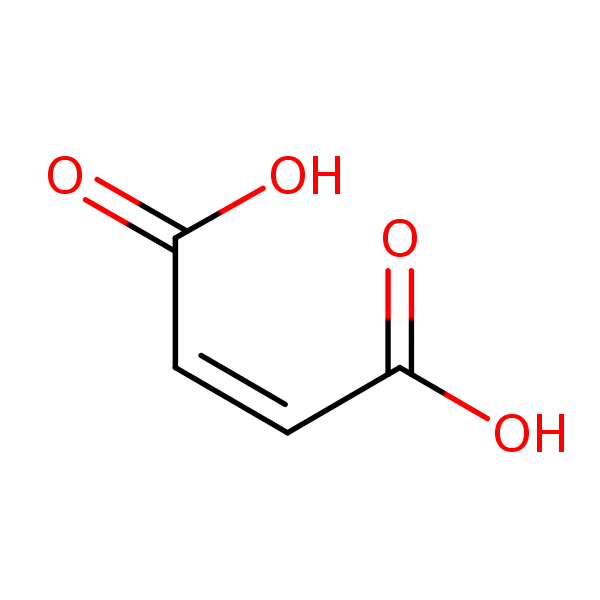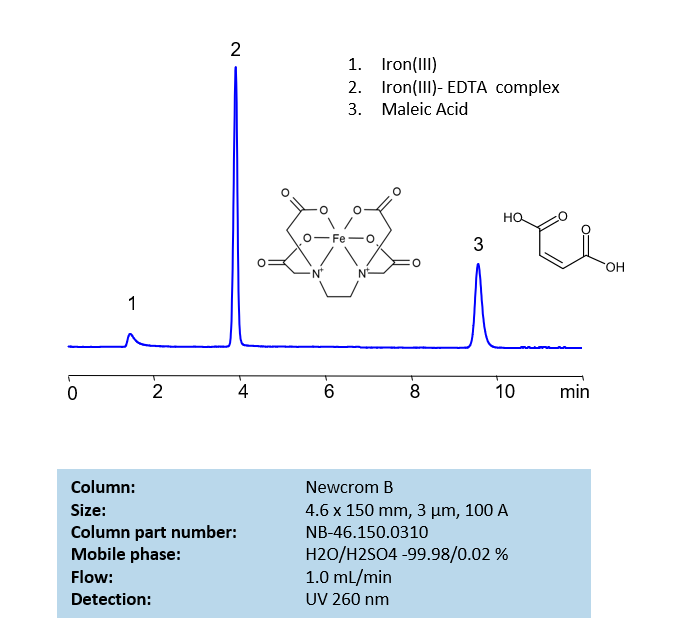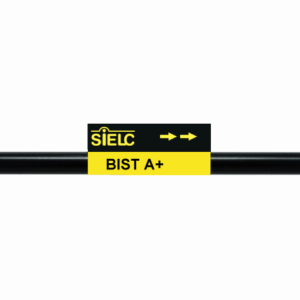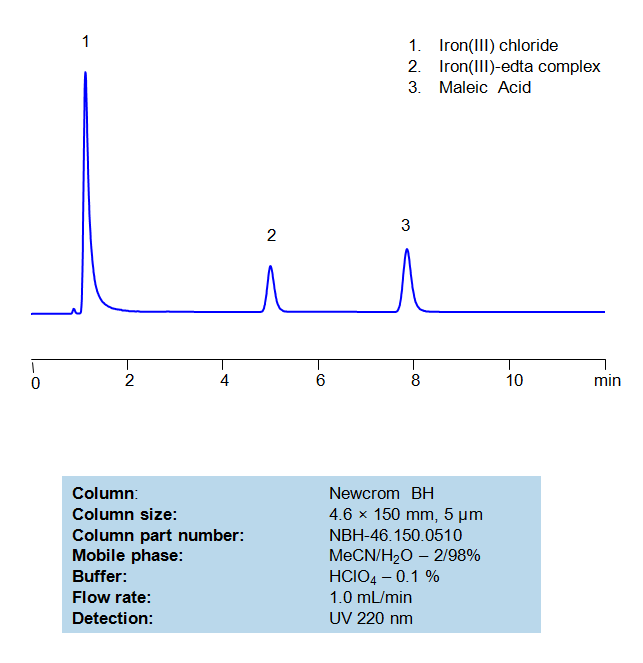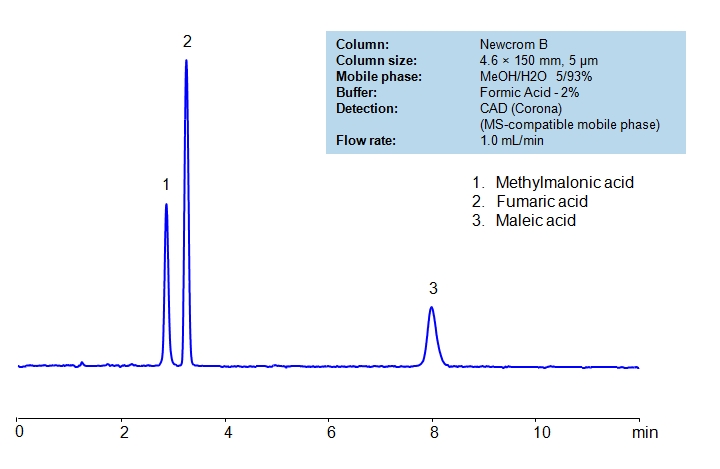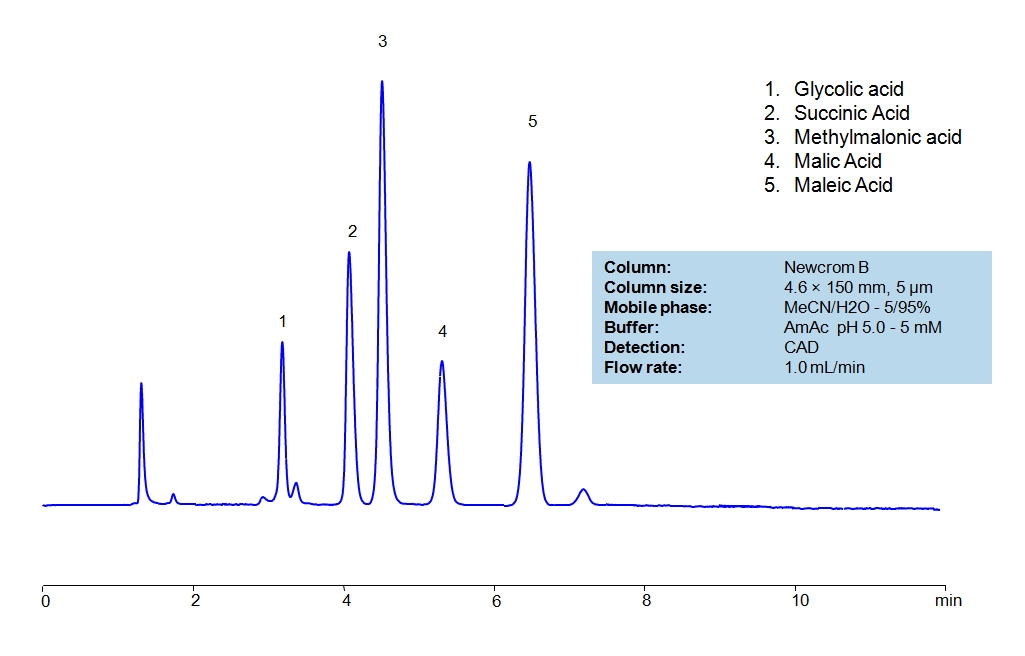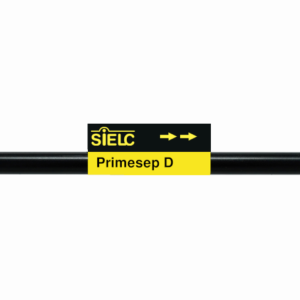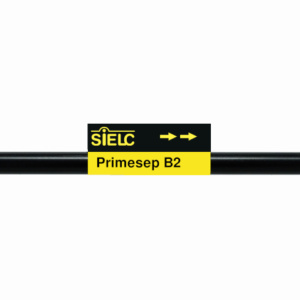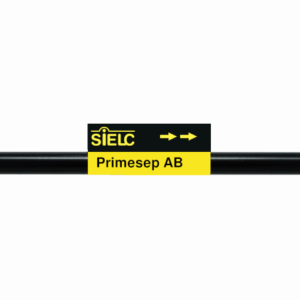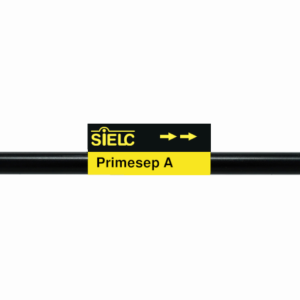| CAS Number | 110-16-7 |
|---|---|
| Molecular Formula | C4H4O4 |
| Molecular Weight | 116.072 |
| InChI Key | VZCYOOQTPOCHFL-UPHRSURJSA-N |
| LogP | -0.480 |
| Synonyms |
|
Applications:
HPLC Method for Analysis of EDTA and Maleic Acid on Newcrom B Column
July 26, 2022
Separation type: Liquid Chromatography Mixed-mode
EDTA Standards Solution A:
For the preparation of the EDTA standard solution, 5 mg of EDTA was accurately weighed and transferred into a 5 mL volumetric flask and dissolved in 0.001N NaOH water solution with sonication or magnetic stirrer mixing. Filtered The EDTA stock solution (1.0 mg/mL) should be stored in a cold dark place and can be used for a week to prepare standards of required concentration.
Iron(III) chloride Solution B:
The standard stock solution of Iron(III) chloride (10 mg/ml) was prepared in water. 50 mg of FeCl3 was accurately weighed and transferred into a 5 mL volumetric flask and dissolved in water, with sonication if needed.
General procedure for Ferric EDTA complex analysis:
To make a sample for analysis mix 100 µL Solution A (or unknown sample) with 100 µL Solution B and 800 µL of water. Place this mixture in a plastic HPLC vial for analysis. Setup instrument and column according to the method provided.
High Performance Liquid Chromatography (HPLC) Method for Analysis of EDTA and Maleic Acid
| Column | Newcrom B, 4.6×150 mm, 100A |
| Mobile Phase | H2O – 99.98% |
| Buffer | H2SO4 – 0.02% |
| Flow Rate | 1.0 ml/min |
| Detection | UV 260 nm |
| Class of Compounds | Acid, Hydrophilic |
| Analyzing Compounds | EDTA, Maleic Acid |
Application Column
Newcrom B
The Newcrom columns are a family of reverse-phase-based columns. Newcrom A, AH, B, and BH are all mixed-mode columns with either positive or negative ion-pairing groups attached to either short (25 Å) or long (100 Å) ligand chains. Newcrom R1 is a special reverse-phase column with low silanol activity.
Select optionsIron(III)
Maleic Acid

HPLC Method for Analysis of Maleic acid, Ascorbic acid, Nicotinic acid, Fumaric acid and Oxalic acid on BIST™ A+ Column
July 8, 2022
Separation type: Bridge Ion Separation Technology, or BIST™ by SIELC Technologies
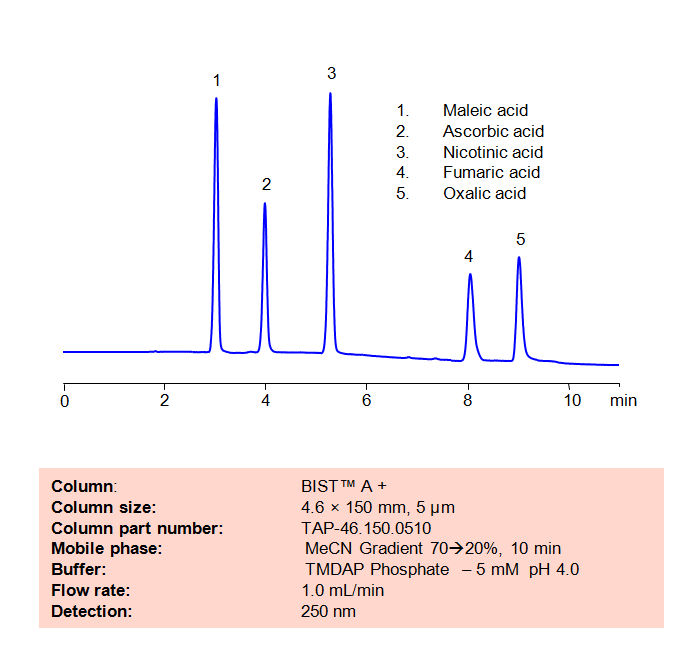
High Performance Liquid Chromatography (HPLC) Method for Analysis of Maleic acid, Ascorbic acid, Nicotinic acid, Fumaric acid and Oxalic acid
The maleate ion from Maleic acid is a popular ingredient as the maleate salt in several different drugs, including Methergine, Pyrilamine, and Carfenazine, among others. Nicotinic acid, also known as Niacin or Vitamin B3, is an essential nutrient for the human body and is sometimes taken as a treatment for high cholesterol. Aconitic acid is a key intermediary in the citric acid cycle, and is also used a flavoring agent and in the production of rubbers and plastics. Fumaric acid is a popular preservative and food additive with a fruit-like taste. Using SIELC’s newly introduced BIST™ method, a mixture of these organic acids can be separated on a negatively-charged, cation-exchange BIST™ A+ column, contrary to conventional chromatographic wisdom. There are two keys to this retention method: 1) a multi-charged, positive buffer, such as N,N,N’,N’-Tetramethyl-1,3-propanediamine (TMDAP), which acts as a bridge, linking the negatively-charged anion analytes to the negatively-charged column surface and 2) a mobile phase consisting mostly of organic solvent (such as MeCN) to minimize the formation of a solvation layer around the charged analytes. Other positively-charged buffers that can generate BIST™ include Calcium acetate and Magnesium acetate. Using this new and unique analysis method, these organic acids can be separated, retained, and detected through ELSD. This method is also compatible with Mass Spectrometry (LC-MS) and CAD.
Condition
| Column | BIST™ A+, 4.6×150 mm, 5 µm, 100A |
| Mobile Phase | MeCN Gradient |
| Buffer | TMDAP ( N,N,N’,N’-Tetramethyl-1,3-diaminopropane) phosphate – 5 mM pH 4.0 |
| Flow Rate | 1.0 ml/min |
| Detection | UV 250 nm |
Description
| Class of Compounds | Acids, Organic acid |
| Analyzing Compounds | Maleic acid, Ascorbic acid, Nicotinic acid, Fumaric acid and Oxalic acid |
Application Column
BIST A+
BIST™ columns offer a unique and effective way to achieve separations that were traditionally challenging or even impossible with other HPLC columns. With the use of a special mobile phase, these ion exchange columns provide very strong retention for analytes with the same charge polarity as the stationary phase, unlocking new chromatography applications. What makes BIST™ columns stand out is their proprietary surface chemistry, which results in superior selectivity, resolution, and sensitivity. These columns offer a simple, efficient solution for a variety of analytical challenges, making them an excellent choice for researchers and analysts across many different fields. To learn more about the technology that powers BIST™ columns and to explore related applications, check out https://BIST.LC.
Select optionsFumaric Acid
Maleic Acid
Nicotinic Acid/Niacin (3-pyridinecarboxylic acid)
Oxalic Acid

HPLC Method for Analysis of Maleic Acid, Nicotinic Acid, Aconitic Acid and Fumaric Acid on BIST™ A+ Column
July 7, 2022
Separation type: Bridge Ion Separation Technology, or BIST™ by SIELC Technologies
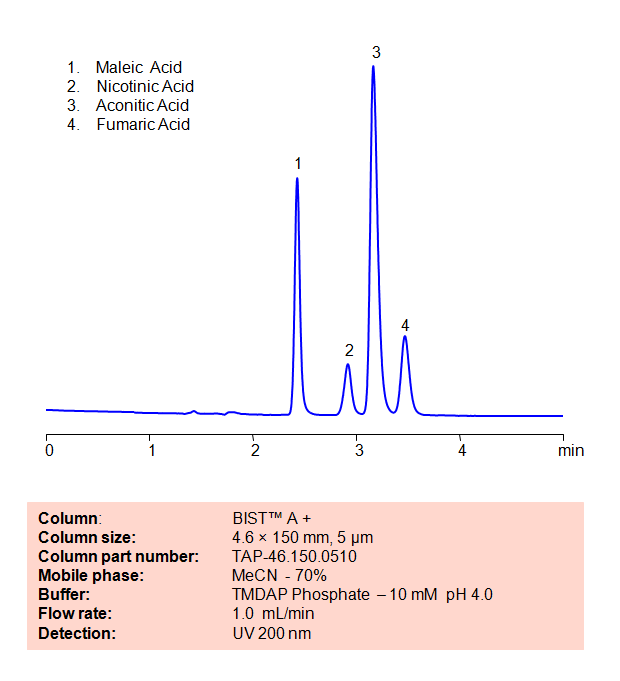
The maleate ion from Maleic acid is a popular ingredient as the maleate salt in several different drugs, including Methergine, Pyrilamine, and Carfenazine, among others. Nicotinic acid, also known as Niacin or Vitamin B3, is an essential nutrient for the human body and is sometimes taken as a treatment for high cholesterol. Aconitic acid is a key intermediary in the citric acid cycle, and is also used a flavoring agent and in the production of rubbers and plastics. Fumaric acid is a popular preservative and food additive with a fruit-like taste. Using SIELC’s newly introduced BIST™ method, a mixture of these organic acids can be separated on a negatively-charged, cation-exchange BIST™ A+ column, contrary to conventional chromatographic wisdom. There are two keys to this retention method: 1) a multi-charged, positive buffer, such as N,N,N’,N’-Tetramethyl-1,3-propanediamine (TMDAP), which acts as a bridge, linking the negatively-charged anion analytes to the negatively-charged column surface and 2) a mobile phase consisting mostly of organic solvent (such as MeCN) to minimize the formation of a solvation layer around the charged analytes.
Condition
| Column | BIST™ A+, 4.6×150 mm, 5 µm, 100A |
| Mobile Phase | MeCN – 70% |
| Buffer | TMDAP ( N,N,N’,N’-Tetramethyl-1,3-diaminopropane) Phosphate – 10 mM pH 4.0 |
| Flow Rate | 1.0 ml/min |
| Detection | UV 200 nm |
Description
| Class of Compounds | Acid, Dicarboxylic acid, Tricarboxylic acid, Pyridinecarboxylic acid |
| Analyzing Compounds | Maleic Acid, Nicotinic Acid, Aconitic Acid, Fumaric Acid |
Application Column
BIST A+
BIST™ columns offer a unique and effective way to achieve separations that were traditionally challenging or even impossible with other HPLC columns. With the use of a special mobile phase, these ion exchange columns provide very strong retention for analytes with the same charge polarity as the stationary phase, unlocking new chromatography applications. What makes BIST™ columns stand out is their proprietary surface chemistry, which results in superior selectivity, resolution, and sensitivity. These columns offer a simple, efficient solution for a variety of analytical challenges, making them an excellent choice for researchers and analysts across many different fields. To learn more about the technology that powers BIST™ columns and to explore related applications, check out https://BIST.LC.
Select optionsFumaric Acid
Maleic Acid
Nicotinic Acid/Niacin (3-pyridinecarboxylic acid)
trans-Aconitic acid

HPLC Method For Analysis Of EDTA and Maleic Acid
April 28, 2022
Separation type: Liquid Chromatography Mixed-mode
Ethylenediaminetetraacetic acid (EDTA) is a very common chelating agent, used particularly for collecting Iron and Calcium ions. It has a wide range of applications, including in the textile industry, paper industry, pharmaceutical industry, and in cosmetics, where it is used to capture unwanted metal ions in solution. Maleic acid, a dicarboxylic acid, has a few interesting applications, such in medicine to form salts with drugs to increase their stability and as a precursor for the production of glyoxylic acid, which is used in cosmetics. An Iron (III)-EDTA complex and Maleic acid can both be retained, separated, and analyzed on a mixed-mode Newcrom BH column with a mobile phase consisting of (mostly) water, Acetonitrile (MeCN), and Perchloric acid (HClO4). This analytical method can be UV detected at 220 nm with high resolution and peak symmetry.
High Performance Liquid Chromatography (HPLC) Method for Analysis of EDTA and Maleic Acid
| Column | Newcrom BH, 4.6×150 mm, 100A |
| Mobile Phase | MeCN – 2% |
| Buffer | HClO4 – 0.1% |
| Flow Rate | 1.0 ml/min |
| Detection | UV 220nm |
| Class of Compounds | Acid, Hydrophilic |
| Analyzing Compounds | EDTA, Maleic Acid |
Application Column
Newcrom BH
The Newcrom columns are a family of reverse-phase-based columns. Newcrom A, AH, B, and BH are all mixed-mode columns with either positive or negative ion-pairing groups attached to either short (25 Å) or long (100 Å) ligand chains. Newcrom R1 is a special reverse-phase column with low silanol activity.
Select optionsIron(III)
Maleic Acid

HPLC Separation of Methylmalonic, Fumaric, Maleic acids on Newcrom B Column
October 28, 2019
HPLC Method for Fumaric Acid, Methylmalonic Acid, Maleic Acid on Newcrom B by SIELC Technologies
High Performance Liquid Chromatography (HPLC) Method for Analysis of Fumaric Acid, Methylmalonic Acid, Maleic Acid
Methylmalonic Acid is an organic acid with the chemical formula C4H6O4. It works as an intermediate in the breakdown of certain amino acids and fatty acids. Elevated levels of Methylmalonic acid can be a sign of a Vitamin B12 deficiency or Methylmalonic acidemia, which is a rare genetic disorder where the previously mentioned acid is not properly metabolized, leading to .
Malonic Acid is an organic acid with the C3H4O4 chemical formula. It has a variety of uses from synthesis to preservatives. When it comes to synthesis, it is often used in industrial means. and especially dyes for natural fibers. Besides industrial use, in laboratory environments, it is used in preparation of tris-maleate, sodium maleate buffers, and maleate salts.
Fumaric Acid, also known as trans-butenedioic acid, is an organic compound with C4H4O4 chemical formula. It is used across food, industrial, and medical industries. In food, is it often used as a preservative, pH regulator, and flavoring akin to citric acid. Industrially, it is used in making polyester resins, polyhydric alcohols, and more. Medically, it is used in denture cleaners and it’s derivatives are used in treating psoriasis.
Fumaric Acid, Methylmalonic Acid, Maleic Acid can be retained and analyzed using the Newcrom B stationary phase column. The analysis utilizes an isocratic method with a simple mobile phase consisting of water and acetonitrile (MeCN) with a formic acid buffer. Detection is performed using CAD.
| Column | Newcrom B, 4.6 x 150 mm, 5 µm, 100 A, dual ended |
| Mobile Phase | MeOH/H2O – 5/93% |
| Buffer | Formic Acid – 2% |
| Flow Rate | 1.0 ml/min |
| Detection | CAD (Corona) (MS-compatible mobile phase) |
| Class of Compounds | Acid, Hydrophilic, Ionizable |
| Analyzing Compounds | Fumaric Acid, Methylmalonic Acid, Maleic Acid |
Application Column
Newcrom B
Column Diameter: 4.6 mm
Column Length: 150 mm
Particle Size: 5 µm
Pore Size: 100 A
Column options: dual ended
Maleic Acid
Methylmalonic Acid

HPLC Separation of Small Organic Acids on Newcrom B Column
October 22, 2019
HPLC Method for Glycolic acid, Malic Acid, Maleic Acid, Methylmalonic Acid, Succinic Acid, Tartaric Acid, dl-Tartaric acid, Fumaric Acid, Citric Acid, Malonic Acid, Gluconic acid on Newcrom B by SIELC Technologies
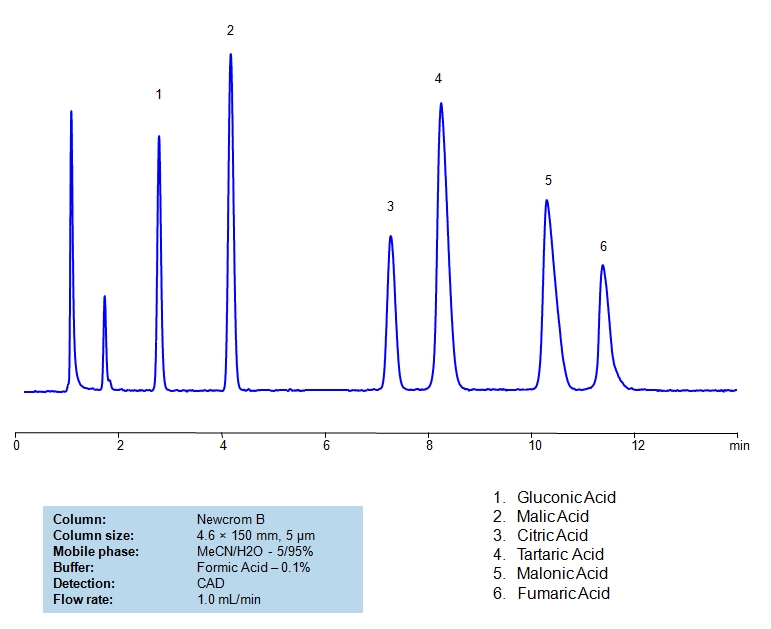
High Performance Liquid Chromatography (HPLC) Method for Analysis of Glycolic acid, Malic Acid, Maleic Acid, Methylmalonic Acid, Succinic Acid, Tartaric Acid, dl-Tartaric acid, Fumaric Acid, Citric Acid, Malonic Acid, Gluconic acid.
Gluconic Acid is an organic acid with the chemical formula C6H12O7. It is naturally found in fruits. Industrially, it is found in honey that is produced by fermenting starch. Typically, it is used in food, beverage, cosmetic, and skin care industries.
Malic Acid is an alpha hydroxy acid with the chemical formula C4H6O5. It is most commonly found in fruits and wines. It is sour, which is partially why it is often used as a food additive. Besides food, it is also used in skin-care as an exfoliant.
Citric Acid is a naturally occurring organic acid found in citrus fruits; it is also an intermediate in the citric acid cycle of aerobic organisms. It is used industrially as an acidity regulator, flavoring, detergent, and more than 2 million tons are produced annually. It’s chemical formula is C₆H₈O₇.
Tartaric Acid is an organic acid with the chemical formula C4H6O6. It is found in fruits like grapes and tamarinds and is a vital component of wine. It is also used in metal cleaning, as an antioxidant, and as an acidulant.
Malonic Acid is an organic compound with the chemical formula C3H4O4. It is also known as cis-butenedioic acid. It is a trans counterpart of fumaric acid. It has a variety of uses from dyeing natural fibers to oil and fat preservative, to synthesis of hydrogels.
Fumaric Acid, also known as trans-butenedioic acid, is an organic compound with C4H4O4 chemical formula. It is used across Food, industrial, and medical industries. In food, is it often used as a preservative, pH regulator, and flavoring akin to citric acid. Industrially, it is used in making polyester resins, polyhydric alcohols, and more. Medically, it is used in denture cleaners and it’s derivatives are used in treating psoriasis.
Glycolic acid, Malic Acid, Maleic Acid, Methylmalonic Acid, Succinic Acid, Tartaric Acid, dl-Tartaric acid, Fumaric Acid, Citric Acid, Malonic Acid, Gluconic acid can be retained and analyzed using the Newcrom B stationary phase column. The analysis utilizes an isocratic method with a simple mobile phase consisting of water and acetonitrile (MeCN). Detection is performed using CAD.
| Column | Newcrom B, 4.6 x 150 mm, 5 µm, 100 A, dual ended |
| Mobile Phase | MeCN/H2O – 5/95% |
| Buffer | AmAc pH 5.0, Formic Acid |
| Flow Rate | 1.0 ml/min |
| Detection | CAD (Corona) MS- compatible mobile phase |
| Class of Compounds | Acid, Hydrophilic, Ionizable |
| Analyzing Compounds | Glycolic acid, Malic Acid, Maleic Acid, Methylmalonic Acid, Succinic Acid, Tartaric Acid, dl-Tartaric acid, Fumaric Acid, Citric Acid, Malonic Acid, Gluconic acid |
Application Column
Newcrom B
Column Diameter: 4.6 mm
Column Length: 150 mm
Particle Size: 5 µm
Pore Size: 100 A
Column options: dual ended
Fumaric Acid
Gluconic acid
Glycolic acid
Maleic Acid
Malic Acid
Malonic Acid
Methylmalonic Acid
Succinic Acid
Tartaric Acid
dl-Tartaric acid

Separation of Compounds in TCA Cycle on Primesep D Column
July 3, 2013
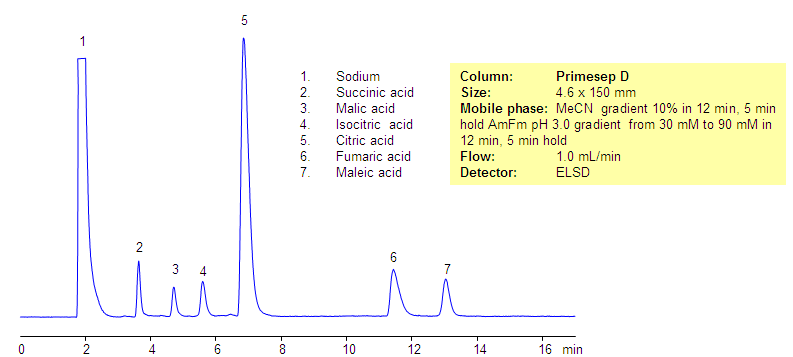
The citric acid cycle (tricarboxylic acid cycle, Krebs cycle) is a key process in the metabolic pathway by which all aerobic organisms generate energy. Compounds generated during TCA are hydrophilic, acidic compounds. Some of the hydrophilic acids are very strong while others are relatively weaker. All compounds have very low hydrophobicity and do not retain by the reversed-phase mechanism on the C18 or C8 HPLC columns. Citric acid and related products were separated in reversed-phase, anion-exchange mode on the Primesep D mixed-mode column. All hydrophilic, acidic compounds are well separated and demonstrate good shape. This robust method can be used for analysis of components of the TCA cycle and other highly hydrophilic compounds. This method is fully compatible with LC/MS and prep chromatography.
| Column | Primesep D, 4.6×150 mm, 5 µm, 100A |
| Mobile Phase | MeCN/H2O |
| Buffer | AmFm, pH 3.0 |
| Flow Rate | 1.0 ml/min |
| Detection | ELSD |
| Class of Compounds |
Acid, Hydrophilic, Ionizable |
| Analyzing Compounds | Sodium, Succinic acid, Malic acid, Isocitric acid, Citric acid, Fumaric acid, Maleic acid |
Application Column
Primesep D
The Primesep family of mixed-mode columns offers a wide variety of stationary phases, boasting unprecedented selectivity in the separation of a broad array of chemical compounds across multiple applications. Corresponding Primesep guard columns, available with all stationary phases, do not require holders. SIELC provides a method development service available to all customers. Inquire about our specially-tailored custom LC-phases for specific separations.
Select optionsFumaric Acid
Isocitric Acid
Maleic Acid
Malic Acid
Sodium
Succinic Acid

Analysis of Compounds of TCA Cycle on SHARC 1 Column
July 2, 2013
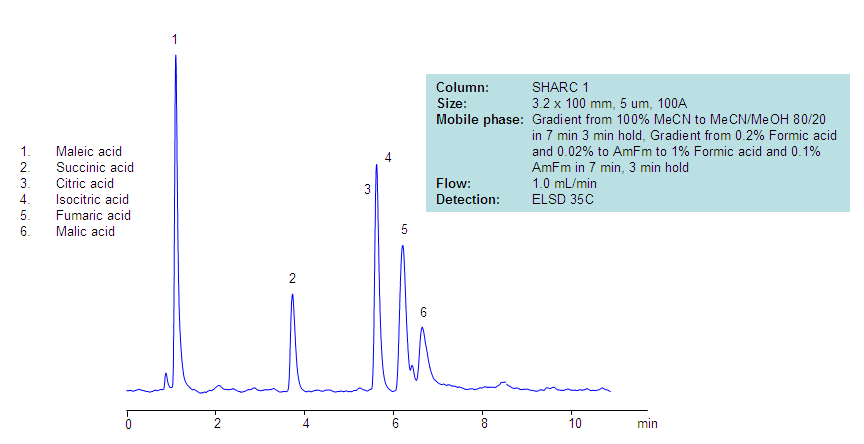
This is an alternative approach for the separation of the TCA cycle intermediates that was developed using novel hydrogen-bonding HPLC column. The organic nature of the mobile phase helps obtain a highly sensitive LC/MS compatible method.
Application Column
SHARC 1
The SHARC™ family of innovative columns represents the first commercially available columns primarily utilizing separation based on hydrogen bonding. SHARC stands for Specific Hydrogen-bond Adsorption Resolution Column. Hydrogen bonding involves an interaction or attraction between a bound hydrogen atom and molecules containing electronegative atoms, such as oxygen, nitrogen, and fluorine.
Select optionsFumaric Acid
Isocitric Acid
Maleic Acid
Malic Acid
Succinic Acid

HPLC Separation of Maleic Acid and Pentaerythritol
July 10, 2012
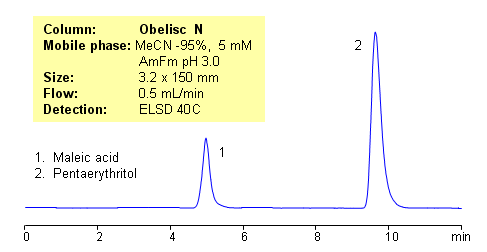
Application Notes: Maleic acid is a small hydrophilic acid, which is poorly retained in reversed-phase chromatography. Pentaerythritol is hydrophilic neutral molecule. A miixed-mode HILIC/anion-exchange method was developed on Obelisc N HPLC column. The retention time for maleic acid can be controlled by amount of ACN, buffer pH, and buffer concentration. Pentaerythritol retention time is only controlled by the amount of acetonitrile. The method is LC/MS and ELSD compatible.
Application Columns: Obelisc N
Application compounds: Maleic Acid, Pentaerythritol
Detection technique: LC/MS, ELSD/CAD
| Column | Obelisc N, 3.2×150 mm, 5 µm, 100A |
| Mobile Phase | MeCN/H2O – 95/5% |
| Buffer | AmFm pH 3.0- 5 mM |
| Flow Rate | 0.5 ml/min |
| Detection | ELSD |
| Class of Compounds |
Acid, Hydrophilic, Ionizable |
| Analyzing Compounds | Maleic Acid, Pentaerythritol |
Application Column
Obelisc N
SIELC has developed the Obelisc™ columns, which are mixed-mode and utilize Liquid Separation Cell technology (LiSC™). These cost-effective columns are the first of their kind to be commercially available and can replace multiple HPLC columns, including reversed-phase (RP), AQ-type reversed-phase, polar-embedded group RP columns, normal-phase, cation-exchange, anion-exchange, ion-exclusion, and HILIC (Hydrophilic Interaction Liquid Chromatography) columns. By controlling just three orthogonal method parameters - buffer concentration, buffer pH, and organic modifier concentration - users can adjust the column properties with pinpoint precision to separate complex mixtures.
Select optionsPentaerythritol
UV Detection

Separation of Maleic and Succinic Acid on Primesep B2 column
July 8, 2011
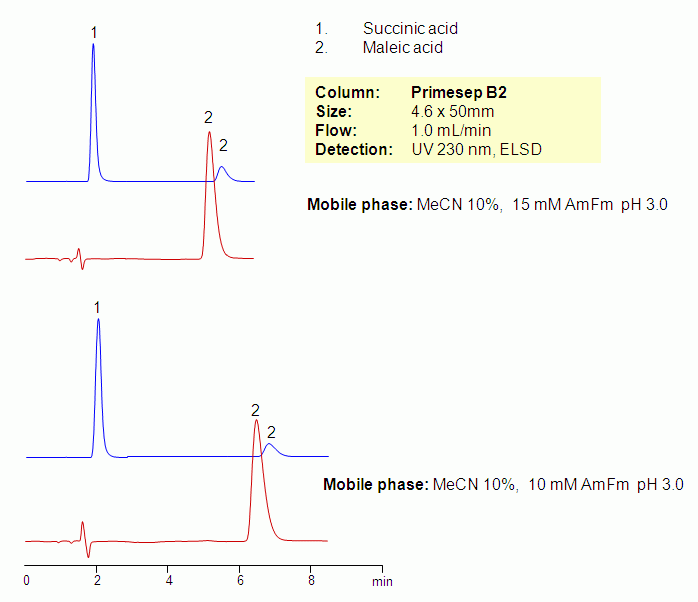
Organic and inorganic acids can be retained and separated on mixed-mode columns based on weak reversed-phase and weak/medium anion-exchange mechanisms. Amount of ACN, buffer concentration and buffer pH will affect retention time of organic and inorganic acids. Acids can be monitored by low UV, ELSD or LC/MS. Presence of ions is required to facilitate ion-exchange mechanism. Method can be used as a general approach for analysis of acidic hydrophilic and acidic hydrophobic compounds. Carboxylic acids along with inorganic acid can be retained and separated without ion-pairing reagent.
| Column | Primesep B2, 4.6×50 mm, 5 µm, 100A |
| Mobile Phase | MeCN/H2O – 10/90% |
| Buffer | AmFm pH 3.0 |
| Flow Rate | 1.0 ml/min |
| Detection | ELSD, UV 230nm |
| Class of Compounds | Acid, Hydrophilic, Ionizable |
| Analyzing Compounds | Succinic Acid, Maleic Acid |
Application Column
Primesep B2
The Primesep family of mixed-mode columns offers a wide variety of stationary phases, boasting unprecedented selectivity in the separation of a broad array of chemical compounds across multiple applications. Corresponding Primesep guard columns, available with all stationary phases, do not require holders. SIELC provides a method development service available to all customers. Inquire about our specially-tailored custom LC-phases for specific separations.
Select optionsOrganic Acids
Succinic Acid
UV Detection

HPLC Analysis of Polar Basic and Acetic Compounds on Primesep AB Column
May 6, 2010
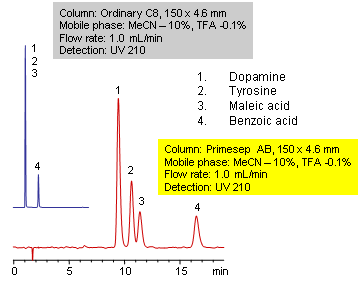
Mixture of polar acidic and basic compounds is separated on a Primesep AB mixed-mode HPLC column. Dopamine and tyrosine are retained by combination of reversed-phase and cation-exchange mechanisms. Maleic acid is retained by anion-exchange mechanism, and benzoic acid is retained by reversed-phase mechanism. Primesep AB is a trimodal column with a C12 hydrophobic chain and cation-exchange and anion exchange groups on the surface. Method utilizes UV detection but can be used with other detection techniques (ELSD, LC/MS, Corona).
| Column | Primesep AB, 4.6×150 mm, 5 µm, 100A |
| Mobile Phase | MeCN/H2O |
| Buffer | TFA – 0.1% |
| Flow Rate | 1.0 ml/min |
| Detection | UV, 210 nm |
| Class of Compounds |
Drug, Acid, Monocarboxylic acid, Hydrophilic, Ionizable, Hormone |
| Analyzing Compounds | Tyrosine, Dopamine, Maleic Acid, Benzoic Acid |
Application Column
Primesep AB
The Primesep family of mixed-mode columns offers a wide variety of stationary phases, boasting unprecedented selectivity in the separation of a broad array of chemical compounds across multiple applications. Corresponding Primesep guard columns, available with all stationary phases, do not require holders. SIELC provides a method development service available to all customers. Inquire about our specially-tailored custom LC-phases for specific separations.
Select optionsDopamine
Maleic Acid
Tyrosine

HPLC Analysis of Basic Drugs and Acidic Counter-Ions by Mixed-Mode Chromatography
July 16, 2009
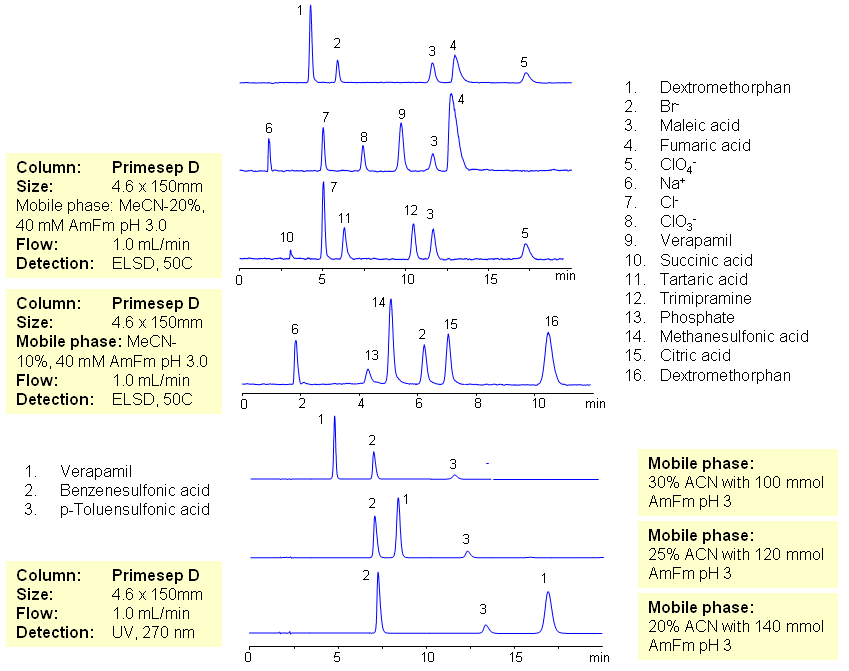
The majority of drugs in the pharmaceutical industry are administered in salt form. The presence of two counter-ions very often necessitates the use of two methods. The nature of these counterparts in drugs can be an inorganic cation and organic acid, inorganic anion and organic base, and organic cation and organic anion. Furthermore, the properties of the molecules will result in a differing stoichiometry. The task of simultaneous quantitation of counter-ions can be achieved by using mixed-mode columns. The general approach for analysis is based on properties of corresponding counter-ions. Hydrophobic basic drugs, like dextromethorphan, verapamil, trimipramine, and corresponding acidic counter-ions (chloride, chlorate, bromide, bromate, perchlorate, maleate, fumarate,tartrate, succinate, phosphate, citrate, benzosulfonate, toleuensulfonate) can be separated and quantitated in the same run on reversed-phase anion-exchange column. Basic hydrophobic drugs are retained by the reversed-phase mechanism, and counter-ions are retained by the reversed-phase and anion-exchange mechanism. Some polar counter-ions are retained only by the anion-exchange mechanism. Retention time and selectivity of HPLC separation of drugs and counter-ions can be achieved by changing the amount of acetonitrile and the amount of ions in the mobile phase. The detection technique depends on the properties of the counter-ions. In case of low or no UV activity, ELSD can be employed if the counter-ion forms a non-volatile salt with the mobile phase additive (ammonium formate). This HPLC method can be used for simultaneous quantitation of other basic drugs and counter-ions. The presence of two mechanisms of retention allows control over retention times of drug and counter-ion independently, and even allows a change of order of elution when necessary.
| Column | Primesep D , 4.6×150 mm, 5 µm, 100A |
| Mobile Phase | MeCN/H2O |
| Buffer | AmFm pH 3.0 |
| Flow Rate | 1.0 ml/min |
| Detection | ELSD, UV 270 |
| Class of Compounds | Ions, Hydrophilic, Hydrophobic, Base, Acids, Ionizable |
| Analyzing Compounds | Sodium Chloride, Sodium chloride, Sodium Chlorate, Sodium bromide, Sodium bromate, Perchloric Acid, Maleic Acid, Fumaric Acid, Tartaric Acid, Succinic Acid, Phosphoric Acid, Citric acid, Benzosulfonic acid, Dextromethorphan, Verapamil, Trimipramine |
Application Column
Primesep D
The Primesep family of mixed-mode columns offers a wide variety of stationary phases, boasting unprecedented selectivity in the separation of a broad array of chemical compounds across multiple applications. Corresponding Primesep guard columns, available with all stationary phases, do not require holders. SIELC provides a method development service available to all customers. Inquire about our specially-tailored custom LC-phases for specific separations.
Select optionsBromide
Chlorate
Chloride
Citric Acid
Dextromethorphan
Fumaric Acid
Maleic Acid
Organic Acids
Perchlorate
Phosphoric Acid
Pyrilamine
Succinic Acid
Tartaric Acid
Verapamil
p-Toluenesulfonic Acid (PTSA)
UV Detection

HPLC Separation of Organics Acids
November 21, 2006
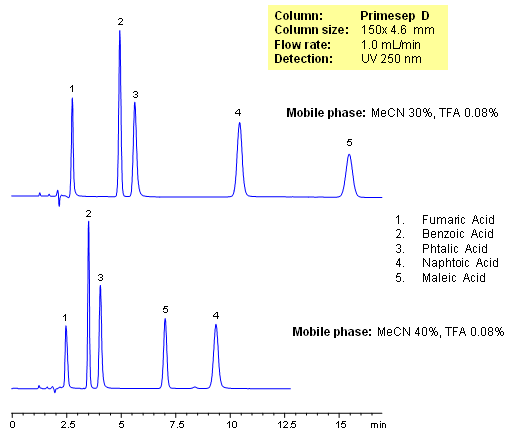
Primesep D separates organic acids such as fumaric, benzoic, phthalic, naphthoic, and maleic acids by a mixture of anion exchange and reversed phase. Retention times and elution order can be changed by adjusting the percentage of acetonitrile in the mobile. This can not be done by traditional ion-exchange and ion-exclusion chromatography. The HPLC separation uses a mobile phase of water, acetonitrile (MeCN, ACN) and trifluoroacetic acid (TFA) and UV detection at 250 nm.
| Column | Primesep D, 4.6×150 mm, 5 µm, 100A |
| Mobile Phase | MeCN/H2O |
| Buffer | AmFm |
| Flow Rate | 1.0 ml/min |
| Detection | UV 250 nm |
| Class of Compounds |
Acid, Hydrophilic, Ionizable |
| Analyzing Compounds | Fumaric Acid, Benzoic Acid, Phthalic Acid, Maleic Acid, Naphtoic Acid |
Application Column
Primesep D
The Primesep family of mixed-mode columns offers a wide variety of stationary phases, boasting unprecedented selectivity in the separation of a broad array of chemical compounds across multiple applications. Corresponding Primesep guard columns, available with all stationary phases, do not require holders. SIELC provides a method development service available to all customers. Inquire about our specially-tailored custom LC-phases for specific separations.
Select optionsFumaric Acid
Maleic Acid
Naphthoic Acid
Organic Acids
Phthalic Acid

Neutral, Base, and Acid on Primesep B Column
November 15, 2005
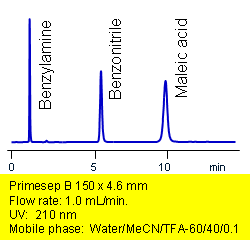
Primesep B separates acids, bases, and neutrals in one injection. Maleic acid, benzonitrile, and benzylamine are baseline resolved by a combination of reversed-phase, ion-exchange, and ion-exclusion mechanisms. Excellent peak shape results with a mass spec compatible mobile phase of water, acetonitrile (MeCN, ACN) and trifluoracetic acid (TFA) with UV detection at 210 nm.
Application Column
Primesep B
The Primesep family of mixed-mode columns offers a wide variety of stationary phases, boasting unprecedented selectivity in the separation of a broad array of chemical compounds across multiple applications. Corresponding Primesep guard columns, available with all stationary phases, do not require holders. SIELC provides a method development service available to all customers. Inquire about our specially-tailored custom LC-phases for specific separations.
Select optionsBenzylamine
Maleic Acid

Neutral, Base, and Acid on Primesep A Column
November 14, 2005
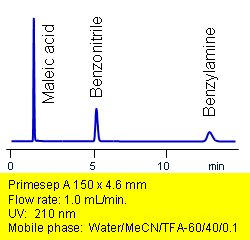
Primesep A separates acids, bases, and neutrals in one injection. Maleic acid, benzonitrile, and benzylamine are baseline resolved by a combination of reversed-phase, ion-exchange, and ion-exclusion mechanisms. Excellent peak shape results with a mass spec compatible mobile phase of water, acetonitrile (MeCN, ACN) and trifluoracetic acid (TFA) with UV detection at 210 nm.
Application Column
Primesep A
The Primesep family of mixed-mode columns offers a wide variety of stationary phases, boasting unprecedented selectivity in the separation of a broad array of chemical compounds across multiple applications. Corresponding Primesep guard columns, available with all stationary phases, do not require holders. SIELC provides a method development service available to all customers. Inquire about our specially-tailored custom LC-phases for specific separations.
Select optionsBenzylamine
Maleic Acid

Neutral, Base, and Acid on Primesep 100 Column
November 14, 2005
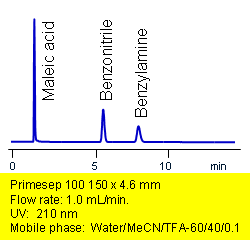
Primesep 100 retains and separates an acid, base, and neutral in one HPLC injection. Maleic acid, benzylamine, and benzonitrile are resolved by ion-exclusion, ion-exhange and reversed-phase modes. The separation uses a mobile phase of water, acetonitrile (MeCN, ACN) and trifluoracetic acid (TFA) with UV detection at 210 nm.
Application Column
Primesep 100
The Primesep family of mixed-mode columns offers a wide variety of stationary phases, boasting unprecedented selectivity in the separation of a broad array of chemical compounds across multiple applications. Corresponding Primesep guard columns, available with all stationary phases, do not require holders. SIELC provides a method development service available to all customers. Inquire about our specially-tailored custom LC-phases for specific separations.
Select optionsBenzylamine
Maleic Acid

Neutral, Base, and Acid on Primesep 200 Column
November 14, 2005
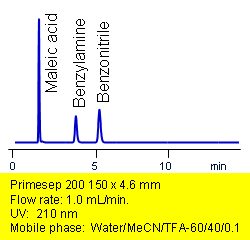
Primesep 200 separates acids, bases, and neutrals in one injection. Maleic acid, benzonitrile, and benzylamine are baseline resolved by a combination of reversed-phase, ion-exchange, and ion-exclusion mechanisms. Excellent peak shape results with a mass spec compatible mobile phase of water, acetonitrile (MeCN, ACN) and trifluoracetic acid (TFA) with UV detection at 210 nm.
Application Column
Primesep 200
The Primesep family of mixed-mode columns offers a wide variety of stationary phases, boasting unprecedented selectivity in the separation of a broad array of chemical compounds across multiple applications. Corresponding Primesep guard columns, available with all stationary phases, do not require holders. SIELC provides a method development service available to all customers. Inquire about our specially-tailored custom LC-phases for specific separations.
Select optionsBenzylamine
Maleic Acid

Separation of Diacid Hydrophobic and Ion Exchange Modes
October 11, 2005
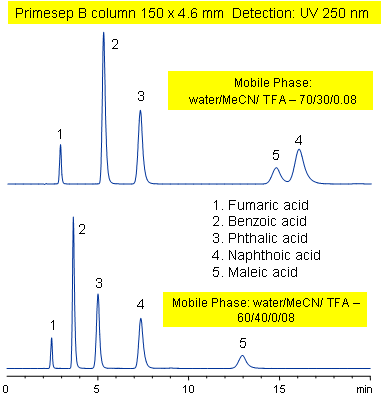
Primesep B combines a hydrophobic, reversed-phase mechanism with ion exchange to separate the diacids, fumaric, benzoic, phthalic, naphthoic, and maleic acids. Changing the acetonitrile content of the mobile phase reverses the peak order for naphthoic and maleic acids. Primesep B combines reversed-phase and anion-exchange mechanism with a mobile phase of water, acetonitrile (MeCN, ACN) and trifluoracetic acid (TFA) and UV detection at 250 nm.
| Column | Primesep B, 4.6×150 mm, 5 µm, 100A |
| Mobile Phase | MeCN/H2O |
| Buffer | TFA |
| Flow Rate | 1.0 ml/min |
| Detection | UV, 250 nm |
| Class of Compounds |
Acid, Hydrophilic, Ionizable |
| Analyzing Compounds | Fumaric acid, Benzoic acid, Phthalic acid, Naphthoic acid, Maleic acid, ) |
Application Column
Primesep B
The Primesep family of mixed-mode columns offers a wide variety of stationary phases, boasting unprecedented selectivity in the separation of a broad array of chemical compounds across multiple applications. Corresponding Primesep guard columns, available with all stationary phases, do not require holders. SIELC provides a method development service available to all customers. Inquire about our specially-tailored custom LC-phases for specific separations.
Select optionsDicarboxylic Acids
Fumaric Acid
Maleic Acid
Naphthoic Acid
Phthalic Acid

Separation of Diacid Hydrophobic and Ion Exclusion Modes
October 4, 2005
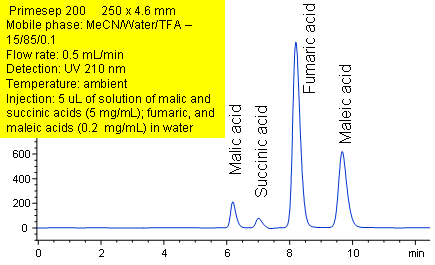
Primesep 200 retains and separates the organic diacids (malic, succinic, fumaric, and maleic) by a combination hydrophobic, reversed-phase interactions and ion exclusion. The separation uses a mobile phase of water, acetonitrile (MeCN, ACN) and trifluoracetic acid (TFA) with UV detection at 210 nm.
Application Column
Primesep 200
The Primesep family of mixed-mode columns offers a wide variety of stationary phases, boasting unprecedented selectivity in the separation of a broad array of chemical compounds across multiple applications. Corresponding Primesep guard columns, available with all stationary phases, do not require holders. SIELC provides a method development service available to all customers. Inquire about our specially-tailored custom LC-phases for specific separations.
Select optionsFumaric Acid
Maleic Acid
Malic Acid
Succinic Acid

Separation of Diacid: Ion Exclusion mode
August 6, 2003
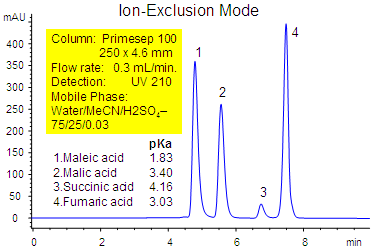
Primesep 100 separates a mixture of dicarboxylic acids in ion-exclusion mode with a mobile phase of water, acetonitrile (MeCN, ACN), and sulfuric acid (H2SO4) with UV detection at 210 nm. Baseline resolution of fumaric, maleic, malic, and succinic acids is obtained in less than 8 minutes. The separation combines ion-exclusion and reversed-phase mechanisms in one method.
Application Column
Primesep 100
The Primesep family of mixed-mode columns offers a wide variety of stationary phases, boasting unprecedented selectivity in the separation of a broad array of chemical compounds across multiple applications. Corresponding Primesep guard columns, available with all stationary phases, do not require holders. SIELC provides a method development service available to all customers. Inquire about our specially-tailored custom LC-phases for specific separations.
Select optionsFumaric Acid
Maleic Acid
Malic Acid
Succinic Acid

